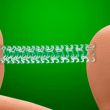Reduced dosage of tenecteplase in elderly patients undergoing a pharmaco-invasive strategy. Delays in achieving timely reperfusion in patients with acute coronary syndrome with ST elevation (STEACS), whether through fibrinolysis or primary percutaneous coronary intervention (PCI), are associated with increased mortality. European guidelines establish a target reperfusion time of 120 minutes after the first medical contact<a href="https://solaci.org/en/2023/07/24/stream-2-reduced-dosage-of-tenecteplase-for-patients-over-60-years-old/" title="Read more" >...</a>
ABSORB IV – Improving Bioresorbable Scaffolds: A Long Road
5-year followup of bioresorbable scaffolds in selected and better prepared lesions (ABSORB IV). Historically, when comparing previously used therapies, such as conventional balloon angioplasty (BA) against bare metal stent (BMS) and later against drug eluting stent (DES) implantation, we see significantly improved outcomes. These advances have shown reduced recoil and more effective restenosis inhibition, compared<a href="https://solaci.org/en/2023/07/19/absorb-iv-improving-bioresorbable-scaffolds-a-long-road/" title="Read more" >...</a>
No Reflow after Primary PCI in STEMI: An Angiographic Analysis of the TOTAL Study
In the early days of percutaneous coronary intervention (PCI) in patients with ST elevation acute myocardial infarction (STEMI), no reflow phenomenon was known as an indicator of the worst possible outcomes in terms of left ventricular remodeling, infarct size, ejection fraction and mortality, at long term. The TOTAL study (Routine Aspiration Thrombectomy with PCI Versus<a href="https://solaci.org/en/2023/07/17/no-reflow-after-primary-pci-in-stemi-an-angiographic-analysis-of-the-total-study/" title="Read more" >...</a>
Mitral Valve Edge to Edge Repair for Papillary Muscle Rupture after Acute Myocardial Infarction
With an approximate incidence of 0.05% to 0.25%, post-acute myocardial infarction (AMI) mitral valve failure caused by papillary muscle rupture is not exactly common. However, it is associated to high mortality rate, ranging between 36% and 80%. Current guidelines recommend surgical treatment, but more often than not surgery involves prohibitive or extremely high risk, with<a href="https://solaci.org/en/2023/07/14/mitral-valve-edge-to-edge-repair-for-papillary-muscle-rupture-after-acute-myocardial-infarction/" title="Read more" >...</a>
Abbreviated Antiaggregant Treatment in High Bleeding Risk Patients from the MASTER-DAPT (15-Month Followup)
Benefits of abbreviated antiaggregant treatment in high bleeding risk patients. Dual antiplatelet therapy (DAPT), established by different guidelines, reduces the risk of ischemic events at the expense of increased bleeding. This habitual APT strategy cannot be applied to patients at high risk of bleeding, which is why this populations are treated with shorter DAPT schemes<a href="https://solaci.org/en/2023/05/15/abbreviated-antiaggregant-treatment-in-high-bleeding-risk-patients-from-the-master-dapt-15-month-followup/" title="Read more" >...</a>
The most read scientific articles in interventional cardiology in February on our website
Below, we share February’s most read scientific abstracts in interventional cardiology at solaci.org. Can Drug Coated Balloon Be a Valid Option for Small Vessels? One of the challenges of percutaneous coronary interventions (PCI) are <2.5 mm vessels, since complications and restenosis complications rate are higher than with >3.0 mm vessels. Is Using Drug-Eluting Balloons and<a href="https://solaci.org/en/2023/03/22/the-most-read-scientific-articles-in-interventional-cardiology-in-february-on-our-website/" title="Read more" >...</a>
Relationship Between Medical Treatment and Long-Term Clinical Results after Peripheral Vascular Intervention
Peripheral arterial disease (PAD) is one of the consequences of atherosclerosis, and it can cause pain in the limbs or tissue loss. Its treatment includes lifestyle changes such as exercise, statin therapy, antiplatelet therapy, antihypertensive medication (mainly ACE inhibitors or ARBs), and revascularization strategy. One in five patients with PAD will have experienced acute myocardial<a href="https://solaci.org/en/2023/02/24/relationship-between-medical-treatment-and-long-term-clinical-results-after-peripheral-vascular-intervention/" title="Read more" >...</a>
Plaque Erosion with No Stenting in Acute Coronary Syndrome: Are There Event Predictors to Avoid This Strategy?
Event predictors in patients with plaque erosion and no stenting. A third of all acute coronary syndrome (ACS) cases are caused by plaque erosion. In the initial EROSION study, it was shown that patients with plaque erosion (as evidenced by OCT, with stenosis <70%, TIMI III flow, and asymptomatic) were stabilized without stent implantation (no<a href="https://solaci.org/en/2023/02/13/plaque-erosion-with-no-stenting-in-acute-coronary-syndrome-are-there-event-predictors-to-avoid-this-strategy/" title="Read more" >...</a>
Is Using Drug-Eluting Balloons and Single Antiplatlelet Therapy Safe for Patients at High Risk for Bleeding Who Undergo Percutaneous Coronary Intervention?
The safety and efficacy of drug-coated balloons (DCB) has been established for the treatment of in-stent restenosis of conventional bare-metal stents (BMS) and drug-eluting stents (DES). Furthermore, these devices are also used to treat de novo coronary lesions, as demonstrated in the BASKET-SMALL 2—where DCBs were non-inferior to stents—and the DEBUT RCT trials—, where DCBs<a href="https://solaci.org/en/2023/02/07/is-using-drug-eluting-balloons-and-single-antiplatlelet-therapy-safe-for-patients-at-high-risk-for-bleeding-who-undergo-percutaneous-coronary-intervention/" title="Read more" >...</a>
Is Clopidogrel Monotherapy Safe After a Month of Dual Antiplatelet Therapy in Diabetic Patients?
Currently, many randomized studies have suggested that short-term dual antiplatelet therapy (DAPT) followed by monotherapy reduces bleeding without increasing major cardiovascular events after percutaneous coronary intervention (PCI). A meta-analysis of six randomized studies has shown this benefit using ticagrelor monotherapy after short DAPT. However, there is no data on the results of clopidogrel monotherapy. Researchers<a href="https://solaci.org/en/2022/12/27/is-clopidogrel-monotherapy-safe-after-a-month-of-dual-antiplatelet-therapy-in-diabetic-patients/" title="Read more" >...</a>









